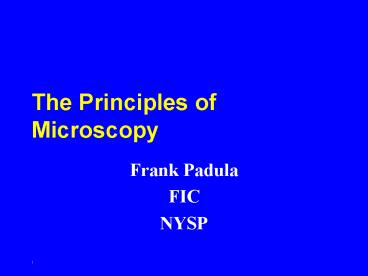The Principles of Microscopy - PowerPoint PPT Presentation
1 / 22
Title:
The Principles of Microscopy
Description:
short focal length more magnification. 6. 7. The Light ... total magnification. product of the magnifications of the ocular lens and the objective lens ... – PowerPoint PPT presentation
Number of Views:1124
Avg rating:3.0/5.0
Title: The Principles of Microscopy
1
The Principles of Microscopy
- Frank Padula
- FIC
- NYSP
2
Scale
3
(No Transcript)
4
Lenses and the Bending of Light
- light is refracted (bent) when passing from one
medium to another - refractive index
- a measure of how greatly a substance slows the
velocity of light - direction and magnitude of bending is determined
by the refractive indexes of the two media
forming the interface
5
Lenses
- focus light rays at a specific place called the
focal point - distance between center of lens and focal point
is the focal length - strength of lens related to focal length
- short focal length ?more magnification
6
(No Transcript)
7
The Light Microscope
- many types
- bright-field microscope
- dark-field microscope
- phase-contrast microscope
- fluorescence microscopes
- are compound microscopes
- image formed by action of ?2 lenses
8
The Bright-Field Microscope
- produces a dark image against a brighter
background - has several objective lenses
- parfocal microscopes remain in focus when
objectives are changed - total magnification
- product of the magnifications of the ocular lens
and the objective lens
9
(No Transcript)
10
Figure 2.4
11
Microscope Resolution
- ability of a lens to separate or distinguish
small objects that are close together - wavelength of light used is major factor in
resolution - shorter wavelength ? greater resolution
12
- working distance
- distance between the front surface of lens and
surface of cover glass or specimen
13
(No Transcript)
14
The Phase-Contrast Microscope
15
The Differential Interference Contrast Microscope
- creates image by detecting differences in
refractive indices and thickness of different
parts of specimen
16
(No Transcript)
17
The Fluorescence Microscope
- exposes specimen to ultraviolet, violet, or blue
light - specimens usually stained with fluorochromes
- shows a bright image of the object resulting from
the fluorescent light emitted by the specimen
18
(No Transcript)
19
Electron Microscopy
- beams of electrons are used to produce images
- wavelength of electron beam is much shorter than
light, resulting in much higher resolution
20
The Scanning Electron Microscope
- uses electrons reflected from the surface of a
specimen to create image - produces a 3-dimensional image of specimens
surface features
21
(No Transcript)
22
Confocal Microscopy
- confocal scanning laser microscope
- laser beam used to illuminate spots on specimen
- computer compiles images created from each point
to generate a 3-dimensional image






























![[PDF] Principles of Molecular Virology 6th Edition Free PowerPoint PPT Presentation](https://s3.amazonaws.com/images.powershow.com/10087820.th0.jpg?_=20240729071)